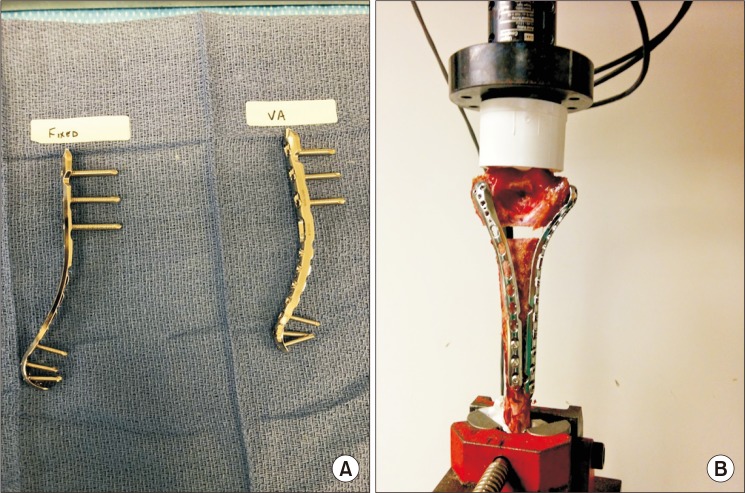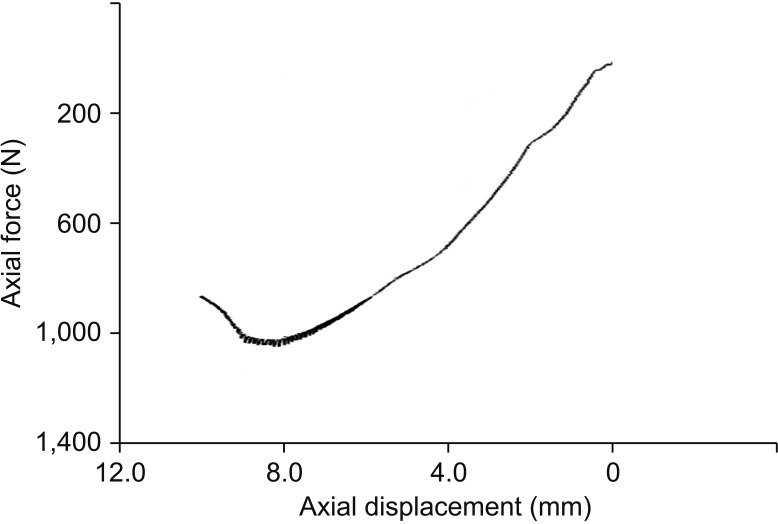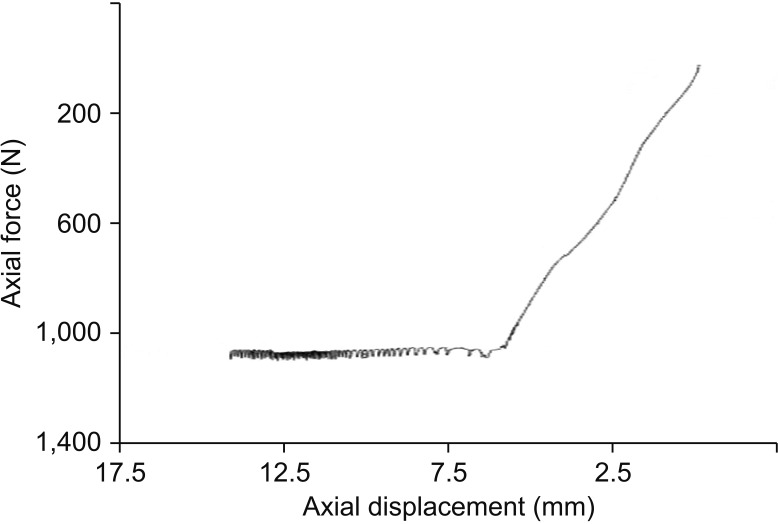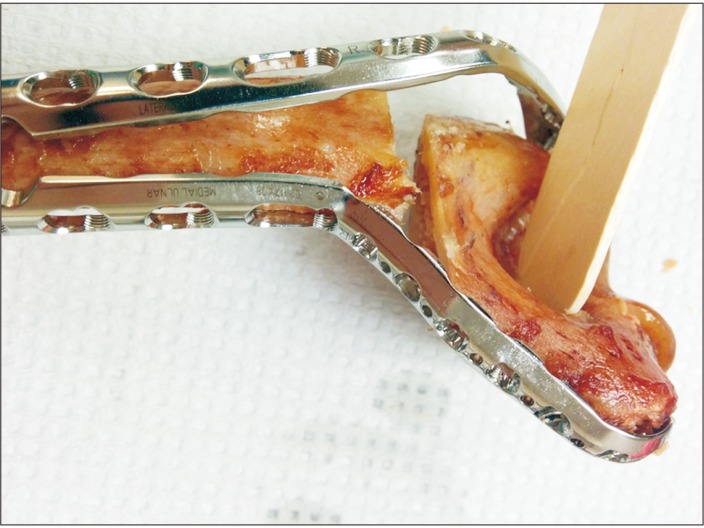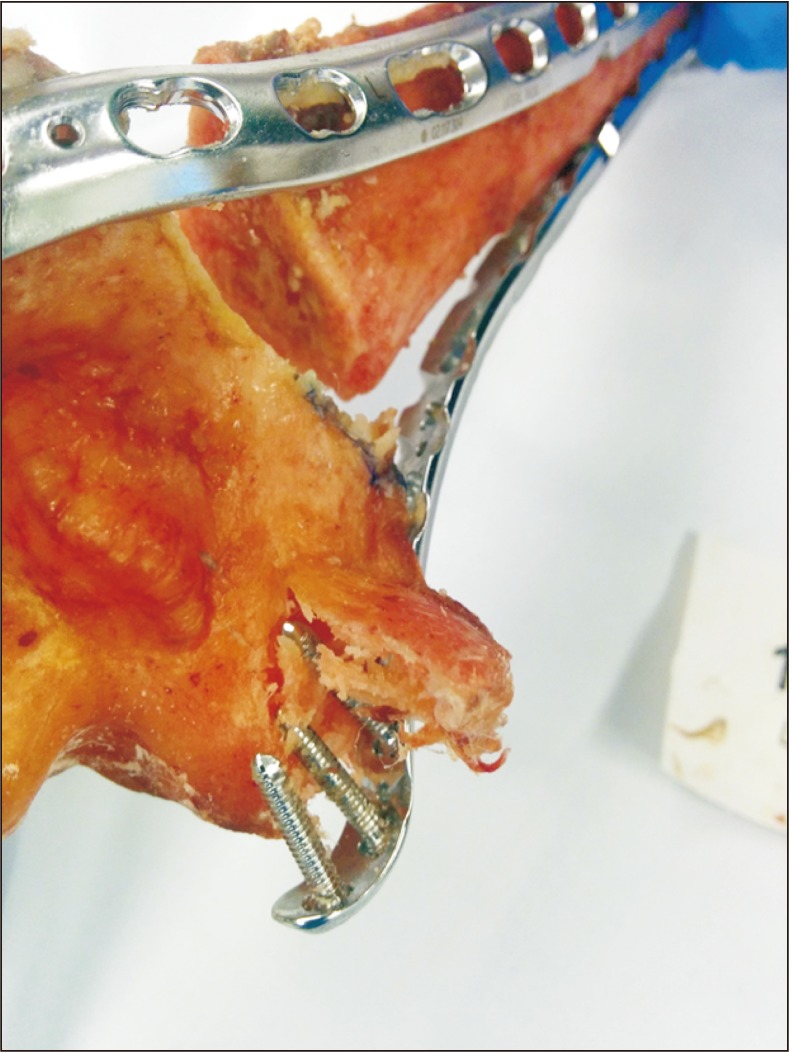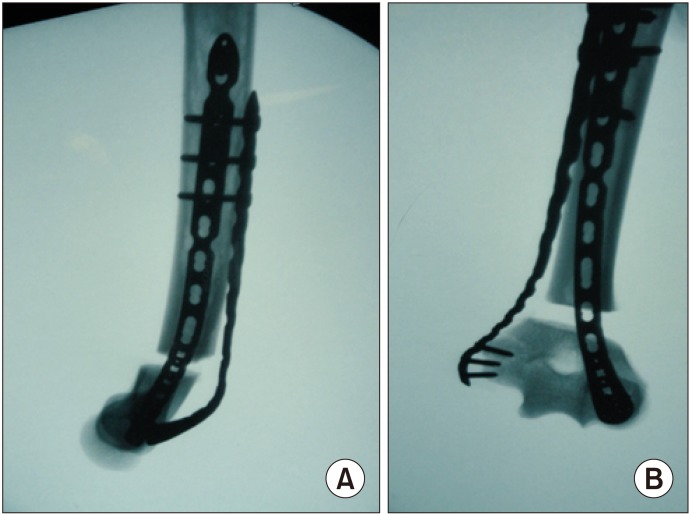Clin Orthop Surg.
2019 Sep;11(3):302-308. 10.4055/cios.2019.11.3.302.
Biomechanical Comparison of Fixed- versus Variable-Angle Locking Screws for Distal Humerus Comminuted Fractures
- Affiliations
-
- 1Department of Orthopedics, WellStar Atlanta Medical Center, Atlanta, GA, USA.
- 2Department of Orthopedics, MetroHealth Medical Center, Cleveland, OH, USA.
- 3Department of Orthopedics, Emory University School of Medicine, Atlanta, GA, USA.
- 4Department of Orthopedics, The Hand and Upper Extremity Center of Georgia, Atlanta, GA, USA. gmlhtc@aol.com
- KMID: 2462559
- DOI: http://doi.org/10.4055/cios.2019.11.3.302
Abstract
- BACKGROUND
To compare the stability of fixed- versus variable-angle locking constructs for the comminuted distal humerus fracture (AO/OTA 13-A3).
METHODS
Eight pairs of complete humeri harvested from eight fresh frozen cadavers were used for the study. We fixed the intact humeri using 2.7-mm/3.5-mm locking VA-LCP stainless steel distal humerus posterolateral (nine-hole) and medial (seven-hole) plates. An oscillating saw was used to cut a 1-cm gap above the olecranon fossa. The specimens were loaded in axial mode with the rate of 1 mm per 10 seconds to failure, and stress-strain curves were compared in each pair. The mode of failure was recorded as well as the load needed for 2- and 4-mm displacement at the lateral end of the gap.
RESULTS
The stiffness of the constructs, based on the slope of the stress-strain curve, did not show any difference between the fixed- versus variable-angle constructs. Likewise, there was no difference between the force needed for 2- or 4-mm displacement at the lateral gap between the fixed- and variable-angle constructs. The mode of failure was bending of both plates in all specimens and screw pull-out in four specimen pairs in addition to the plate bending.
CONCLUSIONS
Our results did not show any difference in the biomechanical stability of the fixed- versus variable-angle constructs. There was not any screw breakage or failure of the plate-screw interface.
Keyword
MeSH Terms
Figure
Reference
-
1. Scolaro JA, Hsu JE, Svach DJ, Mehta S. Plate selection for fixation of extra-articular distal humerus fractures: a biomechanical comparison of three different implants. Injury. 2014; 45(12):2040–2044. PMID: 25249244.
Article2. Egol KA, Kubiak EN, Fulkerson E, Kummer FJ, Koval KJ. Biomechanics of locked plates and screws. J Orthop Trauma. 2004; 18(8):488–493. PMID: 15475843.
Article3. Cronier P, Pietu G, Dujardin C, Bigorre N, Ducellier F, Gerard R. The concept of locking plates. Orthop Traumatol Surg Res. 2010; 96(4):S17–S36.
Article4. Otto RJ, Moed BR, Bledsoe JG. Biomechanical comparison of polyaxial-type locking plates and a fixed-angle locking plate for internal fixation of distal femur fractures. J Orthop Trauma. 2009; 23(9):645–652. PMID: 19897986.
Article5. Stanbury SJ, Salo A, Elfar JC. Biomechanical analysis of a volar variable-angle locking plate: the effect of capturing a distal radial styloid fragment. J Hand Surg Am. 2012; 37(12):2488–2494. PMID: 23174062.
Article6. Cullen AB, Curtiss S, Lee MA. Biomechanical comparison of polyaxial and uniaxial locking plate fixation in a proximal tibial gap model. J Orthop Trauma. 2009; 23(7):507–513. PMID: 19633460.
Article7. Hungerer S, Wipf F, von Oldenburg G, Augat P, Penzkofer R. Complex distal humerus fractures-comparison of polyaxial locking and nonlocking screw configurations: a biomechanical study. J Orthop Trauma. 2014; 28(3):130–136. PMID: 23736772.8. Schwartz A, Oka R, Odell T, Mahar A. Biomechanical comparison of two different periarticular plating systems for stabilization of complex distal humerus fractures. Clin Biomech (Bristol, Avon). 2006; 21(9):950–955.
Article9. Penzkofer R, Hungerer S, Wipf F, von Oldenburg G, Augat P. Anatomical plate configuration affects mechanical performance in distal humerus fractures. Clin Biomech (Bristol, Avon). 2010; 25(10):972–978.
Article10. Hart A, Collins M, Chhatwal D, Steffen T, Harvey EJ, Martineau PA. Can the use of variable-angle volar locking plates compensate for suboptimal plate positioning in unstable distal radius fractures? A biomechanical study. J Orthop Trauma. 2015; 29(1):e1–e6. PMID: 24786734.
Article11. Fornalski S, Gupta R, Lee TQ. Anatomy and biomechanics of the elbow joint. Tech Hand Up Extrem Surg. 2003; 7(4):168–178. PMID: 16518218.
Article12. Halls AA, Travill A. Transmission of pressures across the elbow joint. Anat Rec. 1964; 150:243–247. PMID: 14227963.
Article13. Amis AA, Dowson D, Wright V, Miller JH. The derivation of elbow joint forces, and their relation to prosthesis design. J Med Eng Technol. 1979; 3(5):229–234. PMID: 490614.
Article14. Laksanacharoen S, Wongsiri S. Design of apparatus to study human elbow joint motion. In : IEEE EMBS Asian-Pacific Conference on Biomedical Engineering; 2003; Kyoto, Japan.15. Dunning CE, Zarzour ZD, Patterson SD, Johnson JA, King GJ. Muscle forces and pronation stabilize the lateral ligament deficient elbow. Clin Orthop Relat Res. 2001; (388):118–124.
Article16. Shahid MK, Fletcher M, Robati S, Pemmaraju G. The biomechanical forces that act on the elbow joint. EC Orthop. 2015; 1(1):1–11.17. Nordin M, Frankel VH. Basic biomechanics of the musculoskeletal system. 4th ed. Philadelphia, PA: LWW;2012. p. 352.18. An KN, Hui FC, Morrey BF, Linscheid RL, Chao EY. Muscles across the elbow joint: a biomechanical analysis. J Biomech. 1981; 14(10):659–669. PMID: 7334026.
Article19. Zimmer. NCB® periprosthetic femur plate system [Internet]. Warsaw, IN: Zimmer;2014. cited 2019 Jun 15. Available from: http://www.zimmer.com/medical-professionals/products/trauma/ncb-periprosthetic-femur.html.20. Biomet. POLYAX periarticular plating system [Internet]. Switzerland: Biomet;2014. cited 2019 Jun 15. Available from: https://www.yumpu.com/en/document/view/24185478/polyax-distal-femoral-locked-plating-system-product-biomet.
- Full Text Links
- Actions
-
Cited
- CITED
-
- Close
- Share
- Similar articles
-
- Comparative Analysis of the Results of Fixed-angle versus Variable-angle Volar Locking Plate for Distal Radius Fracture Fixation
- Ulnar Nerve Injury Caused by the Incomplete Insertion of a Screw Head after Internal Fixation with Dual Locking Plates in AO/OTA Type C2 Distal Humerus Fractures
- Failure of Distal Locking Screws in an Intraarticular Distal Radius Fracture Treated with Volar Locking Plate Fixation
- How Many Screws Are Needed for Reliable Stability of Extra-articular Nonosteoporotic Distal Radius Fractures Fixed with Volar Locking Plates?
- Implant Selection for Treatment of Distal Radius Fractures

